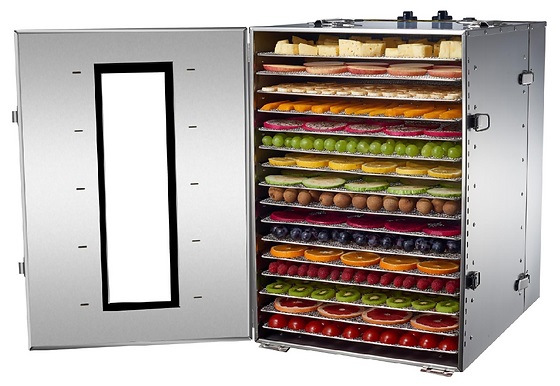A food dehydrator is an electrical appliance designed to remove moisture from food to aid in its preservation. By using heat and a built-in fan, a dehydrator efficiently dries food items while retaining their nutritional value and flavor. This method of food preservation has been used for centuries, and modern technology has made it more accessible and convenient than ever.
How a Food Dehydrator Works
A food dehydrator operates by circulating warm air over the food, which gradually removes moisture. The key components of a dehydrator include:
Heating Element: This component generates the heat necessary to evaporate moisture from the food.
Fan: The fan distributes the warm air evenly across all trays, ensuring consistent drying.
Trays: Food is placed on trays, which are perforated to allow air circulation. Dehydrators typically have multiple trays to accommodate various foods.
Thermostat: A thermostat allows users to control the temperature, which can be adjusted depending on the type of food being dried.
Timer: Many dehydrators come with a timer to automate the drying process, ensuring food is dried for the appropriate duration.
Types of Food Dehydrators
There are several types of food dehydrators available on the market, each with its own set of features and benefits:
Stackable Dehydrators: These dehydrators have trays that stack on top of each other. They are generally more compact and cost-effective but may have uneven drying due to the vertical airflow.
Shelf Dehydrators: Also known as box or cabinet dehydrators, these have horizontal airflow. The trays are arranged like shelves, allowing for more even drying and easier access to food without disturbing other trays.
Commercial Dehydrators: Designed for large-scale dehydration, these are used by businesses and serious home users. They have greater capacity and more powerful fans and heating elements.
Solar Dehydrators: These use solar energy to dry food, making them an eco-friendly option. They are typically less expensive to operate but depend on weather conditions.
Benefits of Using a Food Dehydrator
Preservation: Dehydrating food removes moisture, which inhibits the growth of bacteria, yeast, and mold, extending the shelf life of the food.
Nutrient Retention: Dehydration preserves most of the nutrients and vitamins in food compared to other preservation methods like canning or freezing.
Cost-Effective: Dehydrating food can save money by reducing food waste and allowing for bulk purchases of seasonal produce.
Portability: Dried foods are lightweight and compact, making them easy to store and ideal for hiking, camping, and travel.
Culinary Creativity: Dehydrators can be used to create a variety of snacks, such as fruit leathers, vegetable chips, and jerky, as well as ingredients for soups and stews.
How to Use a Food Dehydrator
Preparation: Wash and peel fruits and vegetables. Cut them into uniform slices to ensure even drying. Marinate or season meats.
Loading the Trays: Arrange the food slices on the trays in a single layer, ensuring they do not overlap to allow proper air circulation.
Setting the Temperature: Different foods require different drying temperatures. Fruits typically need lower temperatures (130°F to 140°F), vegetables slightly higher (125°F to 135°F), and meats require higher temperatures (145°F to 160°F).
Drying Time: The drying time varies based on the type of food, thickness of the slices, and humidity levels. It can range from a few hours to a day. Regularly check the food for the desired dryness.
Storage: Once dried, store the food in airtight containers or vacuum-sealed bags to keep out moisture and air. Properly dried and stored food can last for months or even years.
Popular Uses for a Food Dehydrator
Fruit Leathers: Puree fruit and spread it thinly on dehydrator trays to make homemade fruit rolls.
Vegetable Chips: Slice vegetables like kale, zucchini, and sweet potatoes, season them, and dehydrate for healthy snacks.
Meat: Dehydrate seasoned strips of beef, chicken, or turkey for homemade Meat / Jerkey.
Herbs and Spices: Dry fresh herbs and spices to preserve their flavor for culinary use.
Nuts and Seeds: Soak and then dehydrate nuts and seeds for a crunchy texture and enhanced flavor.
Baked Goods: Use a dehydrator to proof bread or make raw food cookies and crackers.
A food dehydrator is a versatile and valuable tool for anyone interested in preserving food, creating healthy snacks, and exploring culinary creativity. By understanding its functions, benefits, and proper usage, you can maximize the potential of this appliance and enjoy a variety of dehydrated foods year-round. Whether you are an outdoor enthusiast, a home gardener, or someone looking to reduce food waste, a food dehydrator can be a worthwhile investment in your kitchen.

Be First to Comment